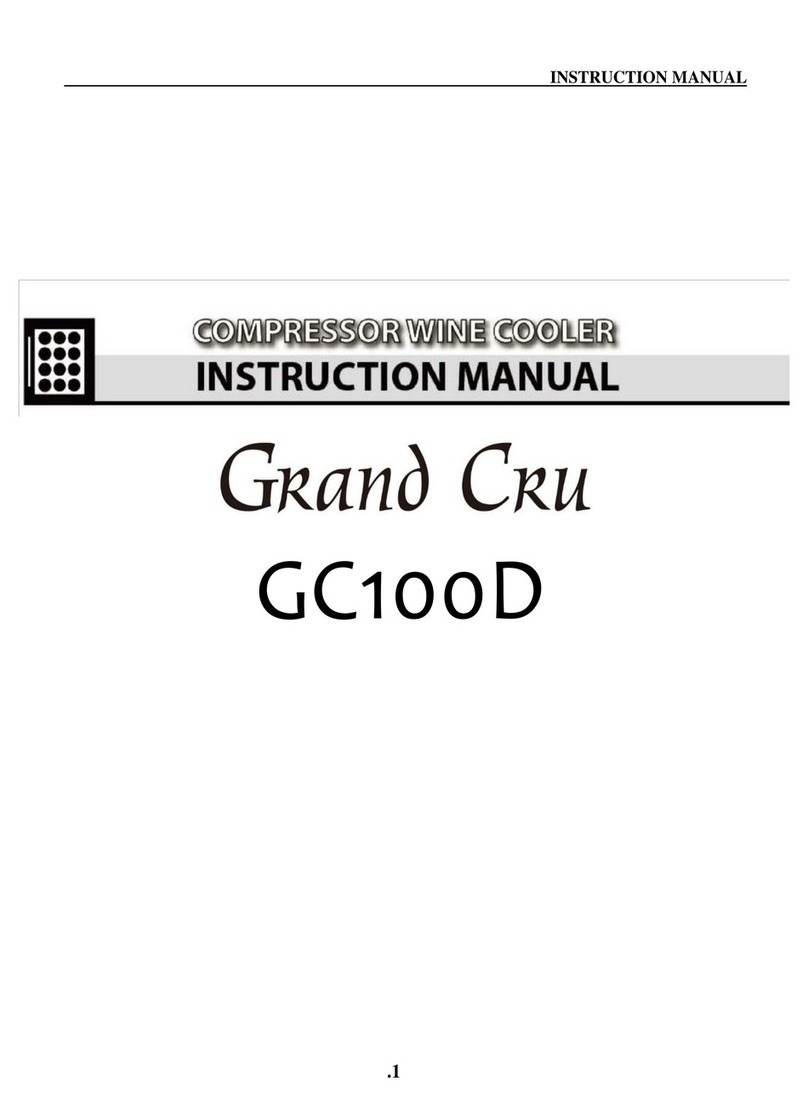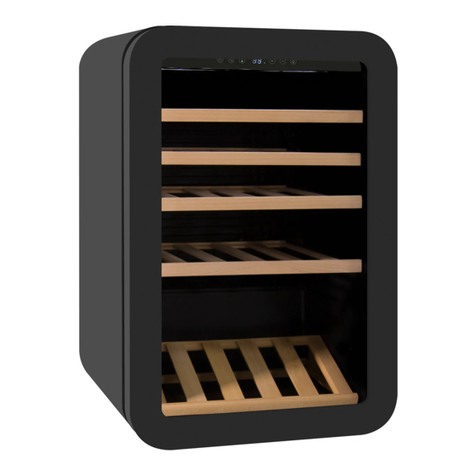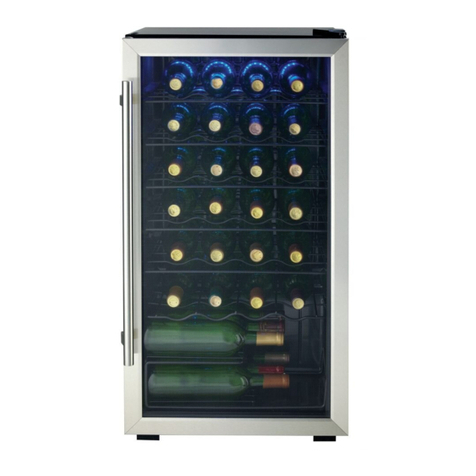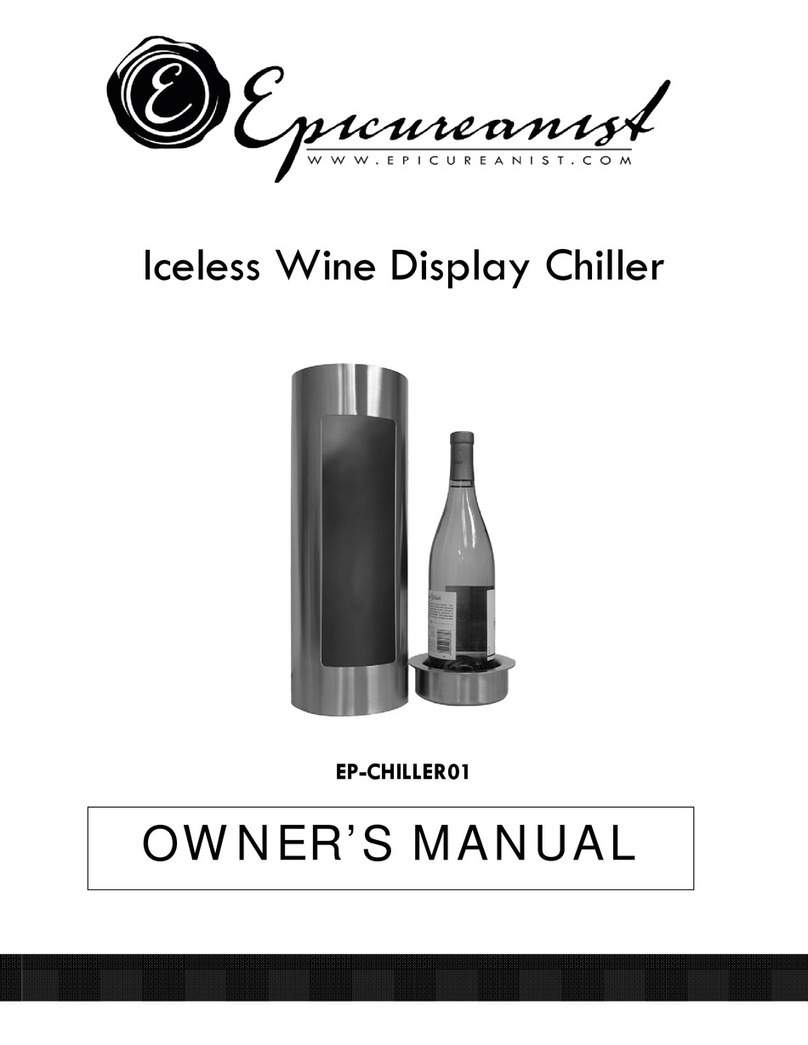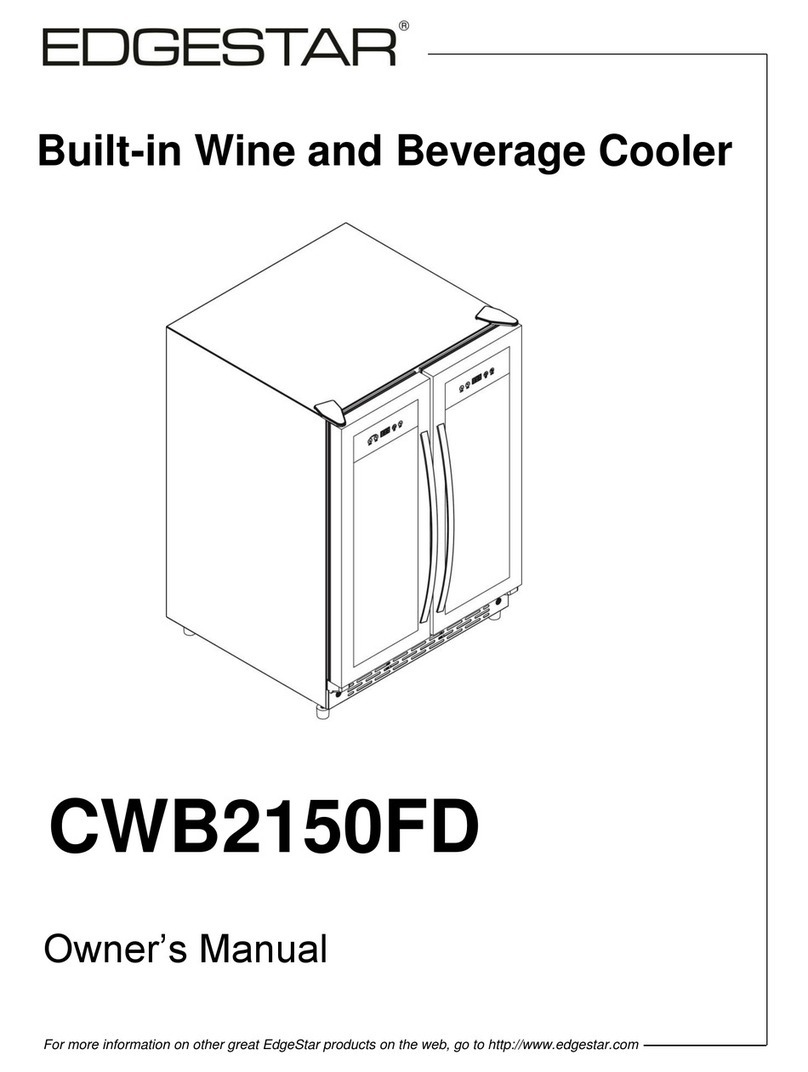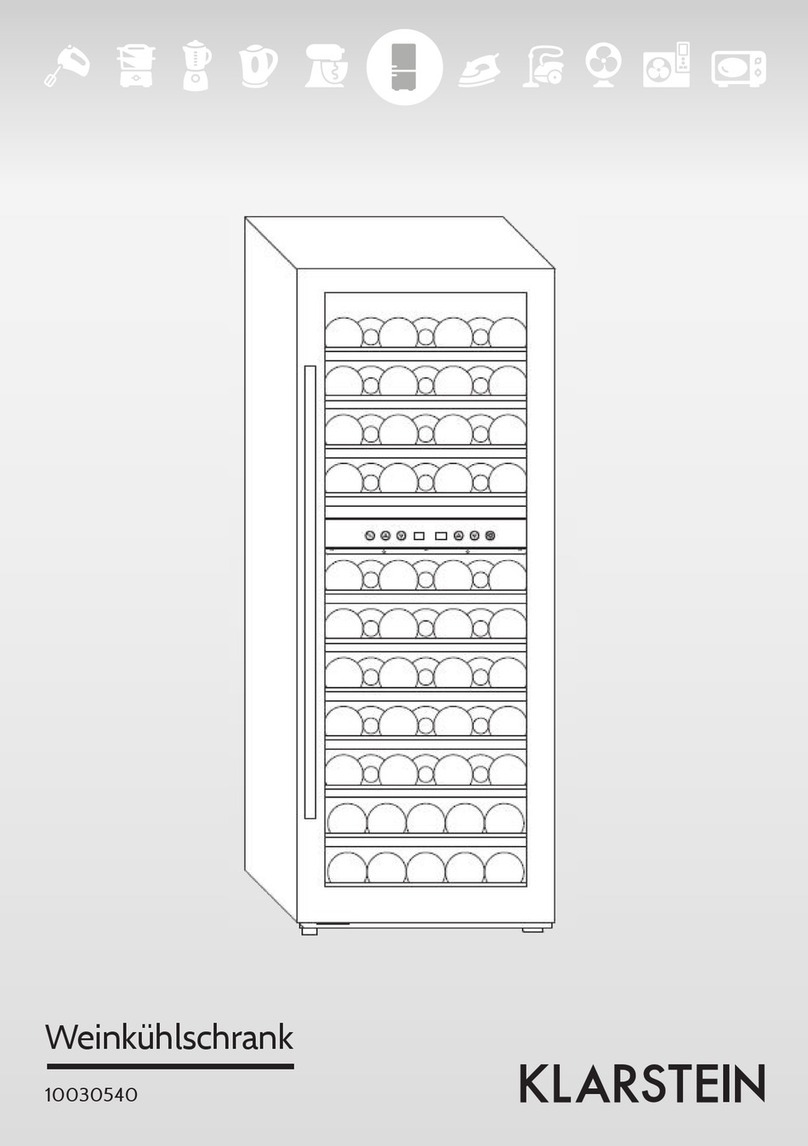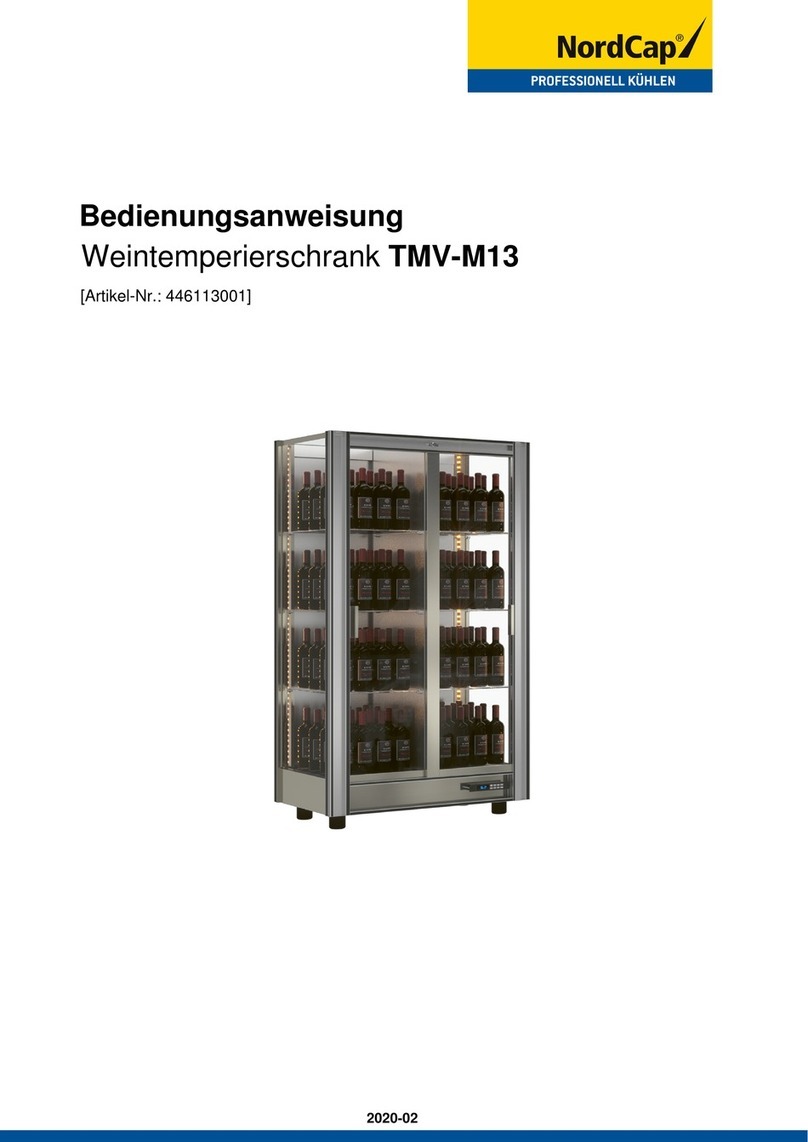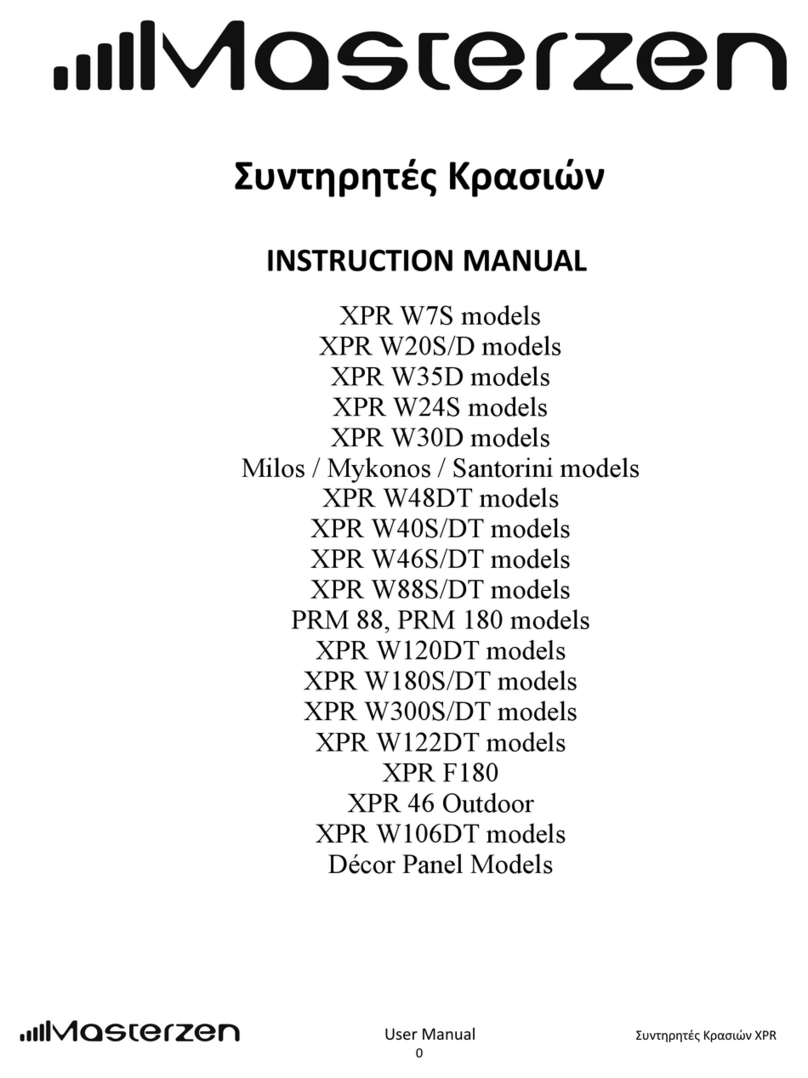Grand Cru GC320 Series User manual

FREE
STANDING
@GrandCruWineFridges
www.grandcruwinefridges.com.au
WINE FRIDGE
GC320 SERIES
OWNERS MANUAL
NEED HELP? CALL
1300 935 683
GRCU4732-User Guide GC320.indd 1GRCU4732-User Guide GC320.indd 1 20/9/22 4:56 pm20/9/22 4:56 pm

GRCU4732-User Guide GC320.indd 2GRCU4732-User Guide GC320.indd 2 20/9/22 4:56 pm20/9/22 4:56 pm

3
IMPORTANT SAFETY INFORMATION .............................................................................. 4
WINE FRIDGE STRUCTURE ............................................................................................. 6
INSTALLATION & OPERATION ........................................................................................ 7
WINE FRIDGE INSTALLATION ..................................................................................................7
TEMPERATURE SETTING ..........................................................................................................7
DISPLAY PLATE FUNCTIONS ....................................................................................................7
INSTALLING FIXED AND SLIDING SHELVES ...........................................................................8
LOADING THE FRIDGE ...............................................................................................................9
HANDLE INSTALLATION ...........................................................................................................9
CARE & MAINTENANCE .................................................................................................10
MAINTENANCE BASICS ..........................................................................................................10
CLEANING THE FRIDGE ..........................................................................................................10
POWER FAILURE .....................................................................................................................10
MOVING THE WINE FRIDGE ....................................................................................................10
ENERGY SAVING TIPS..............................................................................................................10
TROUBLESHOOTING ...................................................................................................... 11
WARRANTY, SERVICE AND SUPPORT ............................................................................13
STORING AND STACKING ..............................................................................................14
DIFFERENT SHAPES & SIZES .................................................................................................14
STACKING FOR AGEING ..........................................................................................................14
STACKING FOR ACCESSIBILITY ..............................................................................................14
FREQUENTLY ASKED QUESTIONS .................................................................................15
WINE STORAGE GUIDE ..................................................................................................19
WINE TEMPERATURE SERVING GUIDE ..........................................................................21
CONTENTS
GRCU4732-User Guide GC320.indd 3GRCU4732-User Guide GC320.indd 3 20/9/22 4:56 pm20/9/22 4:56 pm

4
IMPORTANT SAFETY INFORMATION
IMPORTANT SAFEGUARDS
Before using the appliance, please properly
position and install it as described in
this manual. To avoid the risk of fire,
electrical shock, or injury when using the
appliance, follow these basic precautions:
FOR YOUR SAFETY
• The appliance is intended to be used
exclusively for the storage of wine.
• Make sure the voltage/current marked
on the rating label corresponds with
your supply voltage. Plug into a 3-pin
outlet and avoid the use of an adaptor
or extension lead if possible.
• It is recommended that a separate circuit,
serving only your appliance be provided.
• Never clean the appliance parts
with flammable fluids which may
create a fire hazard or explosion.
• Do not store or use gasoline or other
flammable vapours and liquids in
the vicinity of the appliance.
• Do not connect or disconnect the electric
plug when your hands are wet.
• Unplug the appliance or disconnect
power before cleaning, maintenance
This manual contains important
information including safety and
installation instructions of the appliances.
Please read it carefully before use and
follow all safety information & instructions.
It is recommended to keep this manual for
easy reference so that you can be familiar
with the operation of the appliance.
FREE STANDING SERIES
WINE FRIDGE
GC320 SERIES
or servicing. Failure to do so can
result in electrical shock.
• Do not attempt to repair or
replace any part of the appliance.
All servicing should be referred to a
qualified Grand Cru technician.
• It is recommended that 2 people move
the appliance to avoid any damage to
the appliance or personal injury.
• To ensure proper ventilation for the
appliance, the front of the unit must be
completely unobstructed. Locate the unit
away from direct sunlight and sources
of heat (stove, heater, radiator, etc.).
• It is important for the appliance to be
leveled in order to work properly. You may
adjust the appliance’s feet to level it.
• This appliance intended for use by
persons with sufficient experience and
knowledge of electrical appliances.
• Any other persons (including children)
should be supervised or given instruction
concerning use of the appliance by a
person responsible for their safety.
• Children should be supervised to ensure
that they do not play with the appliance.
• Do not use solvent-based cleaning agents
of abrasives on the interior. These cleaners
may damage or discolor the interior.
GRCU4732-User Guide GC320.indd 4GRCU4732-User Guide GC320.indd 4 20/9/22 4:56 pm20/9/22 4:56 pm

5
• Do not use this appliance for other
than its intended purpose.
• The use of a attachments is not
recommended by the manufacturer
and may be hazardous.
• When you dispose of the appliance, take
off the door and leave the shelves in place
so that children may not easily climb
inside. Make sure the coolant circuit,
particularly the heat exchanger at the
back/bottom of the unit is not damaged.
• The symbol on the product or its
packaging indicates that this product
is not to be handled as normal
household waste and it is to be taken
to a recycling collection point for
electrical and electronic goods.
Warning: Do not damage
the refrigerant circuit.
Warning: Keep ventilation
openings, in the appliance
enclosure or in the built-in
structure, clear of obstruction.
Warning: Do not use
electrical appliances inside
the food storage compartments
of the appliance, unless they
are of the type recommended
by the manufacturer.
Warning: Do not use
mechanical devices or
other means to accelerate the
defrosting process, other than those
recommended by the manufacturer.
POWER SUPPLY CONNECTION
Nominal voltage/Frequency:
220V-240V/50Hz
Standard socket with earth connection
• If the power cord is damaged, or the
plug does not match the socket, and
the socket is not equipped with an
earth connection, etc, you must have
it checked or replaced by a qualified
electrician to prevent any risks.
• If the supply cord is damaged, it must
be replaced by the manufacturer, its
service agent or similarly qualified
persons in order to avoid a hazard.
DISPOSAL INSTRUCTIONS
• Do not dispose of electrical appliances
as unsorted municipal waste, use
separate collection facilities.
• Contact your local government
for information regarding the
collection systems available.
• If electrical appliances are disposed of in
landfills or dumps, hazardous substances
can leak into the groundwater and get into
the food chain, damaging your health and
well-being. When replacing old appliances
with new once, the retailer is legally
obligated to take back your old appliance
for disposal at least for free of charge .
GRCU4732-User Guide GC320.indd 5GRCU4732-User Guide GC320.indd 5 20/9/22 4:56 pm20/9/22 4:56 pm

6
Model GC320
Climate Type N
Electricity Protection Grade I
Volume (L) 760
Refrigerant (g) 62
Foam Material C-pentane
Nominal Voltage (V) 220V-240V
Voltage frequency (Hz) 5OHz
Nominal current (A) 1.25A
Rated Input Power (W) 220W
Power Consumption (kw.h/24h) 1.57
Noise (dB) 40
GW (Kg) 156
NW (Kg) 147
Body Size (mm) 800x690x2015
WINE FRIDGE STRUCTURE
Control Panel
Fridge Body
Storage Shelf
Adjustable Feet
Free Ventilation Hole.
Activated Charcoal Filter
Free Ventilation Base
Door Handle
GRCU4732-User Guide GC320.indd 6GRCU4732-User Guide GC320.indd 6 20/9/22 4:56 pm20/9/22 4:56 pm

7
INSTALLATION & OPERATION
WINE FRIDGE INSTALLATION
• When you receive the fridge, make
sure when you unpack it there is
no flaws in its external appearance
(from shocks, deformation, etc.)
• Open the door and check all interior
fittings and supplied items if are all
complete (shelves, instruction, control
panel, etc.) Please install it according
to the following points if the shelves or
shelf brackets fall off during transit.
• Carry your wine fridge to the final
place to see if there is no problem
with it after checking. Observe
the following when placed:
- Ensure that there is a minimum
of 5cm between your wine fridge
and the left and right wall; leaving
a space of at least 8cm between
the back fridge and the wall.
- Position the wine fridge on a flat
level surface, if not, adjust the feet
of wine fridge to keep level.
- Keep away from sources of heat
and high humidity areas (laundry
room and bathroom, etc).
- Do not tilt it at an angle of more
than 45° when move the fridge.
- Allow a minimum 10-minute interval
between transit and re-starting.
- Make sure the ventilation is free
if you wish to install your fridge
into a worktable, otherwise, it will
reduce the effect of usage.
TEMPERATURE SETTING
The temperature setting range of fridge
is 5-18˚C (41-65˚F). You can reset the
temperature according to your actual
demands. The wine fridge will turn on
and the indicator will turn on until the
desired temperature is achieved.
DISPLAY PLATE FUNCTIONS
Power: Switches the
system ON or OFF
˚C /˚F: Switches temperature
between Fahrenheit and Celsius
Light ON/OFF: Controls the
ON/OFF of LED light
Increase Temperature: Press to
increase the set temperature
Reduce Temperature: Press to
reduce the set temperature
˚C/˚F Temperature
Up
Lock/Unlock
Temperature
Down
Display Light
On/O
Power
On/O
GRCU4732-User Guide GC320.indd 7GRCU4732-User Guide GC320.indd 7 20/9/22 4:56 pm20/9/22 4:56 pm

8
INSTALLING FIXED AND SLIDING SHELVES
Read the following carefully if changing the position of shelf.
• To move a sliding shelf, first remove all bottles, and then remove the sliding shelf by
sliding guides from walls, while making sure not to mix up the right and left guides
Shelf Bracket
Guide
Wall
Wall
Wall
Guide
Fitting the Rear Part of the Guide
Fitting the Front Part of the Guide
Wall
Guide Guide
Wall
GRCU4732-User Guide GC320.indd 8GRCU4732-User Guide GC320.indd 8 20/9/22 4:56 pm20/9/22 4:56 pm

9
Then refit the sliding shelf as shown below:
Guide Sliding Shelf
LOADING THE FRIDGE
The Grand Cru GC320 fridge was designed to
store a maximum number of bottles in total
security, we recommend that you observe
the tips below to ensure optimize loading.
• Spread your bottles out as evenly as
possible over the shelves, so that weight
is not concentrated in one point; also
make sure your bottles do not touch the
back of the fridge, or the step at bottom.
• Also make sure that bottles are
not all grouped together at the
top or bottom of the fridge.
• Observe the loading instructions provided
in according to the type of storage fixtures
with which your fridge is equipped, and
never stack bottles on a sliding shelf.
HANDLE INSTALLATION
If you want to install the handle
according to your actual demands,
do as the following steps:
1. Unhinge the door seal in the
place of installing the handle
2. Cased the screws in the appointed place
3. Fasten the door handle in the
door by screwdriver
4. Refit the door seal to the relevant position
1 2
3 4
DO NOT TURN ON FOR AT LEAST 24 HOURS AFTER DELIVERY
Let the appliance stand upright for approximately 24 hours before
connecting it to the power source, which helps to reduce the possibility
of a cooling-system malfunction from handling during transportation.
GRCU4732-User Guide GC320.indd 9GRCU4732-User Guide GC320.indd 9 20/9/22 4:56 pm20/9/22 4:56 pm

10
CARE & MAINTENANCE
MAINTENANCE BASICS
Your fridge is easy to operate and has
proven its reliability; it will provide
long-lasting satisfaction if you
follow the simple maintenance and
cleaning operations listed below:
• Remove dust from the condenser
(metal screen on the back of
the fridge) twice a year.
• Make sure the power cord is
unplugged before cleaning the back
of your fridge, or before moving it.
• Clean the inside of your fridge thoroughly
once a year, after unplugging and
unloading it (uses water and a mild
cleaning item, then rinse carefully).
CLEANING THE WINE FRIDGE
• Turn off the power, unplug the appliance,
and remove all items including shelves.
• Wipe the inside surfaces with a sponge
and baking soda solution. The solution
should be about 2 tablespoons of
baking soda to 1 litre of warm water.
• Wash the shelves with a mild
detergent solution. Allow the wooden
shelves to dry before placing them
back into the wine fridge.
• Remove excess water from the sponge
or cloth when cleaning the controls, or
any other electrical display areas.
• Wipe the outside fridge with warm
water and a mild liquid detergent.
Wipe dry with a clean soft cloth.
• Do not use steel wool or steel brush
on the stainless steel. These will
contaminate the stainless steel with
steel particles and rusting may occur.
POWER FAILURE
Most power failures are corrected within
a few hours and should not affect the
temperature of your appliance if you
minimize the number of times the door is
opened. If the power is going to be off for
a longer period of time, you need to take
the proper steps to protect your wine.
MOVING THE WINE FRIDGE
• Remove all items.
• Securely tape down all loose items
(shelves) inside your appliance.
• Turn the adjustable legs up to
the base to avoid damage.
• Tape the door shut.
• Ensure the appliance stays secure in the
upright position during transportation.
Also protect the outside of appliance
with a blanket, or similar item.
ENERGY SAVING TIPS
• The appliance should be located away
from heat producing appliances,
and away from direct sunlight.
• Ensure that the unit is adequately
ventilated. Never cover the air vents.
• Only open the door when necessary.
Avoid leaving the door open for long periods
or opening/closing the door frequently.
To assure that your wine
fridge provides long-lasting
reliable performance, you should
check it regularly and inform your
dealer if anything unusual is found.
GRCU4732-User Guide GC320.indd 10GRCU4732-User Guide GC320.indd 10 20/9/22 4:56 pm20/9/22 4:56 pm

11
TROUBLESHOOTING
If you feel the appliance is out of order, follow these instructions to try to see if
you can solve the problem simply by yourself before calling for service.
Problem Problem Possible Cause / Measure
The wine fridge does
not operate
• Not plugged in.
• The appliance is turned off.
• The circuit breaker tripped or a blown fuse.
The wine fridge is
not cold enough
• Check the temperature control setting.
• External environment may require a higher setting.
• The door is opened too frequently.
• The door is not closed completely.
• The door gasket does not seal properly.
Automatically turn-on
and turn-off frequently
• The room temperature is hotter than normal.
• A large amount of contents has been
added to the wine fridge.
• The door is opened too frequently.
• The door is not closed completely.
• The temperature control is not set correctly.
• The door gasket does not seal properly.
The lighting does not work • Not plugged in.
• The circuit breaker tripped or a blown fuse.
• The lighting is turned off.
Too much vibration • Check to assure that the appliance is level.
• Check to assure no parts inside the fridge or
in the compressor chamber are loose.
The wine fridge seems to
make too much noise
• The rattling noise may come from the flow
of the refrigerant, which is normal.
• As each cycle ends, you may hear gurgling
sounds caused by the flow of refrigerant.
• Contraction and expansion of the inside walls
may cause popping and crackling noises.
• The appliance is not level.
The door will not close properly. • The wine fridge is not level.
• The door was reversed and not properly installed.
• The gasket is dirty.
• The shelves are out of position.
GRCU4732-User Guide GC320.indd 11GRCU4732-User Guide GC320.indd 11 20/9/22 4:56 pm20/9/22 4:56 pm

12
Compressor does not start
even though the desired
temperature is lower than the
temperature in the room.
• Check the wall socket by plugging in any
type of electrical device, and make sure that
the on/off switch is in the “I” position.
• If the compressor still does not start after
taking steps 2 and 3, contact your dealer.
Dew on the fridge surface • The surface of wine fridge especially the
glass door will appear some frost if the
fridge is installed in a damp room.
• This is due to the moisture in the air
coming into contact with the fridge.
• Please wipe it away with dry cloth.
Liquid sounds • The sound of compressor when
starts or stops working
• The flowing sound of refrigerant
in the refrigeration system
• The evaporating sound of
refrigerant in the evaporator
It’s a normal phenomenon if appears upward sound.
Condensation inside the fridge If you are in the environment with high level
of humidity or if the door of wine fridge has
been left open for a long period or opened
frequently, wipe off the door and walls and
leave the door closed as long as possible.
GRCU4732-User Guide GC320.indd 12GRCU4732-User Guide GC320.indd 12 20/9/22 4:56 pm20/9/22 4:56 pm

13
Thank you for purchasing a Grand Cru Wine Fridge from Home Icon International Pty
Ltd. Home Icon provides a 5-year warranty on the Grand Cru range of Wine Fridges.
WARRANTY REGISTRATION
Register your wine fridge now for warranty, and allow us to
provide you with the best possible after sales service:
1. Please log on to our website at www.grandcruwinefridges.com.au
2. Click on the ‘Support’ tab across the top
3. Select ‘Warranty Registration’ and fi ll out the details as required
This warranty does not cover the following:
• Any damages caused from improper use or not used in
accordance with the instruction manuals.
• Damage caused by connecting your product to the wrong power source/supply.
• Incorrect installation or modifi cations made during installation or use of the product.
• Removing screws or otherwise opening the outer case will void the warranty.
• Any damages resulting from poor handling or moving of the
product, misuse, fi re or water damage etc.
• Failure to maintain the product as per the Instruction Manual.
• Problems caused by incorrect or inadequate venting of the product.
SERVICE AND SUPPORT
Should an instance arrive where you require assistance, contact our support team:
1. Please log on to our website at www.grandcruwinefridges.com.au
2. Click on the ‘Support’ tab across the top
3. Select the ‘Request a Service’ option and fi ll out the details as required
NEED HELP? CALL
1300 935 683
WARRANTY, SERVICE AND SUPPORT
GRCU4732-User Guide GC320.indd 13GRCU4732-User Guide GC320.indd 13 20/9/22 4:56 pm20/9/22 4:56 pm

14
STACKING FOR STORING & SERVING
DIFFERENT SHAPES AND SIZES
This brochure makes reference to the
‘standard Bordeaux style bottle’ when
specifying capacity. However, wine
producers use a huge range of different
bottle shapes and sizes. Bottle shape variety
should be considered when selecting the
appropriate Grand Cru cabinet in which
to house your precious collection, since
shelf height and adjustability varies across
the product range. Please also be aware
that some bottles will not fi t opposite
each other on the same shelf and this
may affect capacity. You may need to lay
the bottles opposite more suitably shaped
bottles. Ideally, bottles should lie with
their necks comfortably interlocking.
STACKING FOR AGEING
When fi lling your cabinet, we suggest
stacking the bottles you wish to cellar
and mature at the back of the shelves,
and the wines you wish to consume
in the shortterm at the front.
STACKING FOR ACCESSIBILITY
When stacking bottles, it is practical to
keep bottles from the same case together.
See diagrams below, in which bottles
from the same case are represented by
the same colours. Vertically stacking
same-case bottles enables safe and
easy access to all your different wines.
FRONT VIEW - SINGLE ROW
FRONT VIEW - STACKED ROW
FRONT VIEW - DOUBLE ROW
Back Row
Front Row
TOP VIEW – SINGLE ROW
SERVING
SERVING
SERVING
SERVING
SERVING
SERVING
SERVING
SERVING
STORING
STORING
STORING
STORING
STORING
STORING
STORING
Maximum shelf capacity: 30 bottles per shelf
Maximum shelf weight: 38kg
STORING AND STACKING
GRCU4732-User Guide GC320.indd 14GRCU4732-User Guide GC320.indd 14 20/9/22 4:56 pm20/9/22 4:56 pm

15
CHOOSING THE RIGHT WINE FRIDGE
To keep my wines ready to serve at
the perfect drinking temperatures?
Choose any Dual-Zone Grand Cru wine
fridge, and keep in mind that most whites
are generally best served at 6-8 deg C, and
most reds at 16-18 deg C. With a Dual-
Zone cabinet, you can fi ne-tune the serving
temperatures of different styles of wine: You
can set the temperature to suit your needs.
To store my wines in the ideal cellaring
conditions so they can mature?
Choose any Grand Cru Wine fridge, and
make sure you set it at 12-14 deg C as this
is the proper temperature for cellaring and
medium/long term storage for all wines:
reds, whites, roses and champagne.
To cellar only white wines
or only red wines?
All wines cellar at the same temperature
(12-14 deg C), so any Single-Zone fridge
set between 12-14 deg C is ideal for white
wine and/or red wine storage. When set
within this temperature range, Single-
Zone fridges will also keep humidity
levels above 55% (which is important to
maintain the integrity of the cork). Having
said that, any dual zone can also be kept
at the same temperature and humidity
levels throughout the whole unit.
To cellar both red and white wines?
All wines — Whites, Reds, Champagnes
— cellar at the same temperature (12-
14 deg C), so any Grand Cru fridge set
between 12-14 deg C is ideal for white
wine and/or red wine storage. Set within
this temperature range, Grand Cru
wine fridges will also keep humidity
levels above 55% (which is important
to maintain the integrity of the cork).
My wine is purely for investment:
which wine fridge will suit me best?
For (investment) wine to appreciate in value,
the discerning purchaser will want a wine
fridge that is designed for cellaring at the
perfect temperature so any of the Grand Cru
units will suit that purpose – it just becomes
more of a question of the size of unit needed.
FREQUENTLY ASKED QUESTIONS
GRCU4732-User Guide GC320.indd 15GRCU4732-User Guide GC320.indd 15 20/9/22 4:56 pm20/9/22 4:56 pm

16
WINE TEMPERATURE
At what temperature should I
be cellaring my wines?
The recommended cellaring temperature
is between 12 and 14 degrees Celsius.
Whichever temperature you choose,
the key is to remember that the
temperature must be constant.
What should the humidity levels
be in my wine cabinet?
The humidity in a wine cabinet should
be over 55% so that corks don’t dry out
and shrink: humidity levels below 55%
can lead to your wines spoiling because
of oxidation. All Grand Cru wine fridges
are designed to maintain humidity levels
above 55% (when set at 12-14 deg C).
Do I need humidity control
when cellaring my wines?
YES, humidity is essential to ensure that
the corks do not dry out. If that happens,
they shrink and air can get into the wine.
If air gets into the wine it will cause
oxidation, generating an odorous smell.
How long can I keep my wines in
a Dual -Zone wine fridge?
As long as the temperature is correct,
there is no limit to how long your
wine can be stored in there.
Can I use my wine fridge for beer and food?
No, wine fridges are not normal fridges.
The temperature does not go low enough
to keep food fresh and are not cold enough
for the serving of beer. The Grand Cru
GC46BC Beverage Centre is designed
for beers (or white wines at drinking
temperature), as they can cool beverages
down to 2 deg C, and have metallic racks
on which to stand beer bottles up. However,
they are not suitable for food storage.
I have a Dual-Zone wine cabinet. Can I
use one compartment for the serving
of my white wines and the bottom
compartment for cellaring my wines?
YES. Just set the top compartment
temperature to between 6*-8* and the bottom
section to a temperature range of 12*-14*.
TECHNICAL & INSTALLATION
What is the difference between Dual-Zone
cabinets and Single-Zone wine cabinets?
Dual -Zone wine fridges are designed for
keeping and serving red and white wines
at the perfect drinking temperatures.
Single-Zone wine cabinets are designed for
cellaring all wines (reds, whites or sparkling)
at the proper temperature (12-14 deg C).
Does my cabinet require ventilation
and can it be built-in under bench?
Some of the Grand Cru range are not
suitable for built –in installation, so
please consider this before purchasing.
The following Grand Cru wine fridges
are suitable for built in installation:
GC46, GC100, GC166, GC183 & GC194.
TROUBLE SHOOTING
My unit is making a lot of noise
If your wine fridge sounds noisy, it may be:
1) due to incorrect stacking of bottles and/
or the fridge is not completely level, so
please empty the unit, check the levelling
and then reload, 2) because ventilation
requirements have not been considered,
and so the unit is over-heating —refer to the
manual or call Grand Cru for further help.
There is water coming out of
the back of my cabinet.
The door has been left open to some
degree. Please wipe out the unit
and ensure the door is shut.
GRCU4732-User Guide GC320.indd 16GRCU4732-User Guide GC320.indd 16 20/9/22 4:56 pm20/9/22 4:56 pm

17
There is water on the inside
back wall of my cabinet
This is a perfectly normal occurrence
and needed to maintain the correct
humidity in the wine fridge. Just keep
your bottles away from the wall so
you do not block the water fl ow, an
essential part of the cellaring climate.
My bottles are wet
If they are in contact with the back wall of the
cabinet, they will have some condensation
on them so please make sure you keep a
fi nger’s distance between the bottom of the
bottle and the wall when you load. If not,
please keep in mind that it is normal that
condensation appears on the bottles after
you open the door, and that high humidity is
essential in cellaring your wine properly.
There is a +/- 2 deg temperature
swing on the digital readout
Yes, this in normal. It is the variance in
the air temperature that triggers the
thermostat and the compressor. The small
temperature fl uctuations occur in the air
around the bottles, not in the wine itself.
There is condensation on the outer surface
of the glass door of my wine cabinet
This indicates excessive humidity
in the environment.
What happens if there is a power outage?
The units are very well insulated and can
maintain the temperature for hours before
there is any change in the temperature itself.
We don’t advise opening the doors during
the outage. Once the power is restored,
electronically-controlled cabinets can revert
to factory settings, so reset as necessary.
SHIPPING & DELIVERY
What happens if my home/
property is damaged?
While this scenario is extremely rare, it can
occur. If anything at your home/property is
damaged by the carrier, contact Customer
Support immediately! We will make the
initial arraignments with the carrier to
get compensation to you in a quick and
timely fashion. As always, notate the BOL
of what was damaged before you sign!
Note: Grand Cru cannot give direct
compensation for damages that occur
to your home/property before and/or
after the fact. These actions have to be
negotiated through you and the carrier,
but as our customer we will give you all
the necessary information and assistance
needed to make sure you have a timely
and satisfactory resolution to the matter.
I signed for my wine cellar as delivered for
in satisfactory condition, but I discovered
damage later on. What do I do?
If this occurs, please contact Customer
Support immediately! There is a window of
48 hours where you would still be entitled
to a replacement and/or compensation.
After the window lapses, we cannot provide
a replacement or compensation as the
wine cellar is offi cially signed off “AS IS”
I am receiving or I have received delivery
and certain services are not being rendered
or were not rendered. What do I do?
Contact Customer Support so we can look
into the matter directly with the carrier.
We may be able to have the services
rendered and/or provide compensation for
the inconvenience. Note: Make sure you are
informed of what services that are and are
not included in your delivery. Refer to this
information packet or you can discuss this
at the time of purchase with your Home Icon
Customer Representative before delivery.
GRCU4732-User Guide GC320.indd 17GRCU4732-User Guide GC320.indd 17 20/9/22 4:56 pm20/9/22 4:56 pm

18
Does the carrier install/assemble
any components (such as shelving)
at the time of delivery?
No. We cannot nor do we authorise the
carrier to install shelving or assemble any
part of the wine fridge. This is always the
responsibility of the client regardless of
what services are being rendered. If you
require a white glove unpacking service,
please contact Customer Support to fi nd
out more as this feature incurs a fee.
We hope that this has been informative
and insightful information that will
help you not only on your purchase,
but as well as the delivery process.
Should you have any further questions
in regards to this information and/
or should you have questions that are
not included in this information packet
please do not hesitate to contact us.
Customer Support: 1300 935 683
Email: [email protected]
NEED HELP? CALL
1300 935 683
GRCU4732-User Guide GC320.indd 18GRCU4732-User Guide GC320.indd 18 20/9/22 4:56 pm20/9/22 4:56 pm

19
SOME HELPFUL ADVICE
Have you bought some nice wine that you
are planning keep for a special occasion
or maybe you wish to start your own
wine collection. What are the best tips
for successfully storing your wine?
Firstly, it’s useful to remember that
only a small percentage of fi ne wines
on the market benefi t from long-term
aging. Most wines are best enjoyed within
a few years of release. If you’re looking
to buy wines to mature, you should
really consider investing in a proper
wine fridge or an external wine storage
solution, but more about that later.
For everyone else, however, following a
few simple guidelines should keep your
wines safe until you’re ready to drink them.
1. KEEP IT COOL
Heat is enemy number one for wine.
Temperatures higher than 21°C will age a
wine more quickly than is usually desirable.
And if it gets too much hotter, your wine
may get “cooked,” resulting in fl at aromas
and fl avours. The ideal temperature range
is between 7°C and 18°C (and 14°C is often
cited as close to perfect), though this isn’t
an exact science. Don’t worry too much if
your storage runs a couple degrees warmer,
as long as you’re opening the bottles
within a few years from their release.
2. BUT NOT COLD
Keeping wines in your household
refrigerator is fi ne for a couple months,
but it’s not a good bet for the longer term.
The average fridge temp sits between
3 - 4°C to safely store perishable foods,
and the lack of moisture (humidity) could
eventually dry out corks, which might
allow air to seep into the bottles and
damage the wine. Keeping wine in a fridge
for a longer time will also slow down
the aging process which is not ideal.
3. CONSISTENCY IS THE KEY
More important than worrying about
achieving a perfect 12°C is avoiding the
landmines of rapid, extreme or frequent
temperature variations. Temperature
variation is likely to be more critical for
older wines where the seal of the cork
is less tight (corks lose some elasticity
WINE STORAGE GUIDE
GRCU4732-User Guide GC320.indd 19GRCU4732-User Guide GC320.indd 19 20/9/22 4:56 pm20/9/22 4:56 pm

20
with age). The problem with temperature
variations is that the volume of the wine
expands as temperature rises, decreasing
the ullage volume, and then contracts
as temperature falls, increasing the
ullage volume. If the closure is providing
a completely airtight seal then this is
of relatively little consequence. Aim for
consistency, but don’t get paranoid about
minor temperature fl uctuations; wines may
see worse in transit from the winery to the
store. (Even if heat has caused wine to seep
out past the cork, that doesn’t always mean
the wine is ruined. There’s no way to know
until you open it—it could still be superb).
4. TURN OFF THE LIGHTS
Light, especially sunlight, can pose
a potential problem for long-term
storage. The sun’s UV rays can degrade
and prematurely age wine. One of the
reasons why vintners use coloured
glass bottles? They’re like sunglasses
for wine. Light from household bulbs
probably won’t damage the wine itself,
but can fade your labels in the long run.
5. HUMIDITY IS IMPORTANT
BUT NOT CRITICAL
Conventional wisdom says that wines
should be stored at an ideal humidity
level of 70 percent. The theory goes
that dry air will dry out the corks, which
would let air into the bottle and spoil the
wine. Yes, this does happen, but unless
you live in a very dry desert or arctic like
climate, it probably won’t happen to you.
Anywhere between 50 percent and 80
percent humidity is considered safe, and
placing a tray or saucepan of water in
your storage area can improve conditions.
Conversely, extremely damp conditions
can promote mould. This won’t affect a
properly sealed wine, but can damage
the labels. A dehumidifi er can fi x that.
6. FLAT OR STANDING –
STORING OR ON SHOW
Traditionally, bottles have been stored
on their sides in order to keep the liquid
up against the cork, which theoretically
should keep the cork from drying out.
If you’re planning on drinking these
bottles in the near-term, or if the bottles
have alternative closures (screw caps or
synthetic corks), this is not necessary.
7. LIMIT THE MOVEMENT
There are theories that vibration could
damage wine in the long term by speeding
up the chemical reactions in the liquid.
Some serious collectors worry about even
the subtle vibrations caused by electronic
and other appliances, though there’s
little evidence supporting the impacts of
this. Signifi cant vibrations could possibly
disturb the sediment in older wines and
keep them from settling, potentially
making them unpleasantly gritty.
WHERE SHOULD I STORE MY WINE?
If you do not have a cool, not-too-damp
basement or underground garage that can
double as a fridge, you can improvise with
some simple wine racks in a safe place.
Rule out your kitchen or laundry, where
hot temperatures could affect your wines,
and look for a location that is generally less
effected by climate control systems and
not directly in line with sun light pouring in
from a window. Perhaps there is a little-
used closet or other vacant storage area
that could be repurposed for storing wine?
GRCU4732-User Guide GC320.indd 20GRCU4732-User Guide GC320.indd 20 20/9/22 4:56 pm20/9/22 4:56 pm
Table of contents
Other Grand Cru Wine Cooler manuals
Popular Wine Cooler manuals by other brands
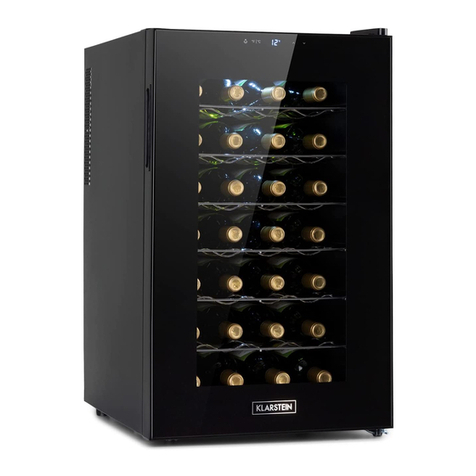
Klarstein
Klarstein Barolo 28 Uno Installation

Candy
Candy CWCEL 210 user manual
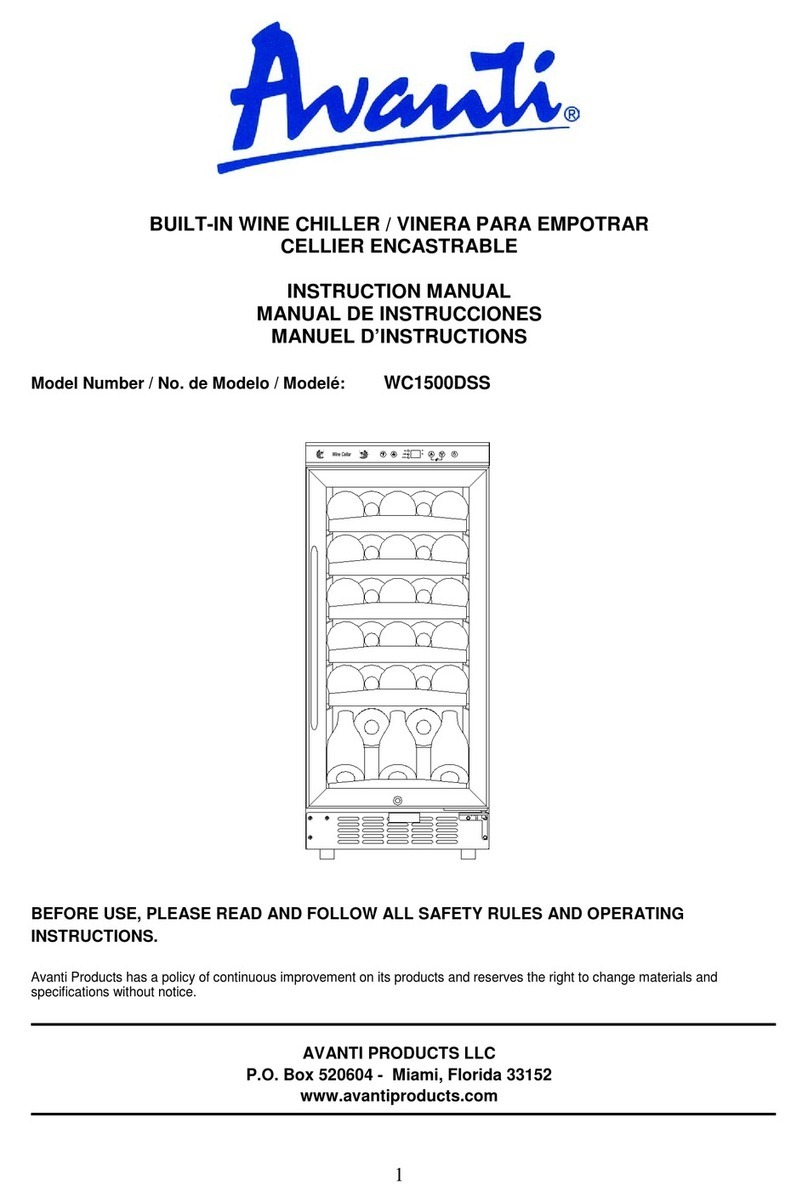
Awanti
Awanti WC1500DSS instruction manual
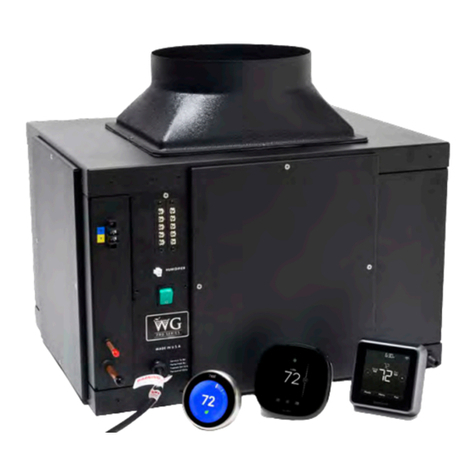
Wine Guardian
Wine Guardian PRO Series Installation, operation and maintenance guide
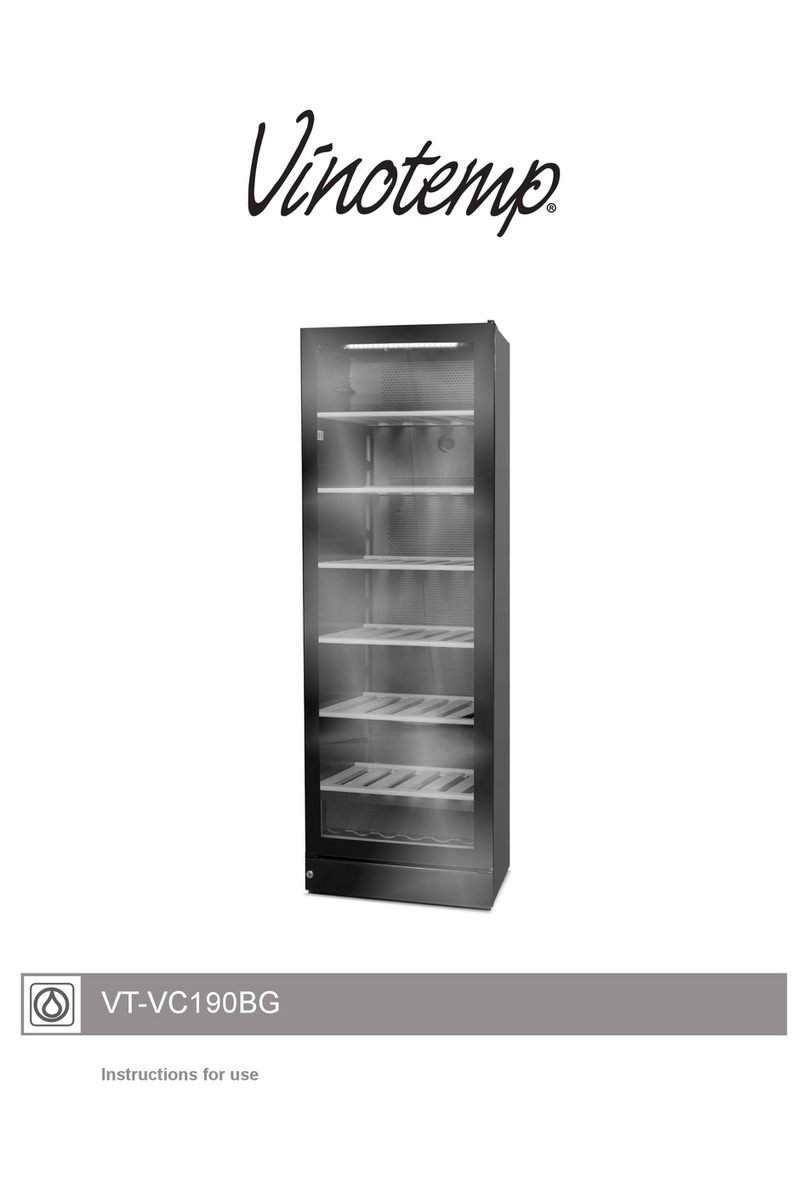
Vinotemp
Vinotemp VT-VC190BG Instructions for use
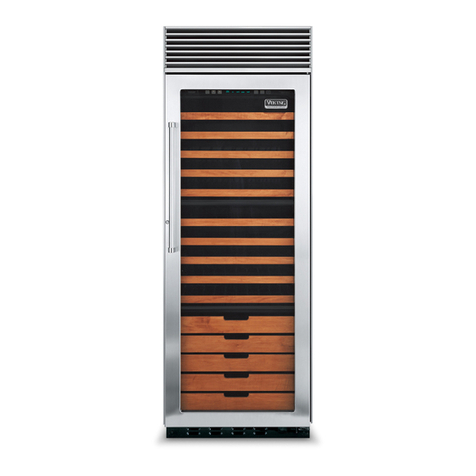
Viking
Viking Designer DDWB300 installation instructions
